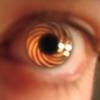Yesterday I mentioned that when I asked my coworker if he was up for games at 2:00 PM he immediately asked which colors I saw. I just answered and then quickly made jokes to get off the subject. He didn’t reply but he did show up for games at lunch.
During the play he started talking about it again, explaining how he saw white and gold.
Then another coworker agreed, and another.
So I took the chance to ask them how they were seeing white and gold, and according to their explanations I was correct. They are seeing blue pixels, but calculating white based on how they envision the lighting.
It turns out they know that they are doing the calculation into white, so no, I’d not call that bonkers. What I meant I would classify as “bonkers” (and I made this clear in the first post) is not that they see a white dress, it’s that they see white pixels, which is what it sounded as if some people were seeing. But even that isn’t a fair accusation to make since as dsm1891 mentioned there could be monitor issues, and later I also thought color-blindness might play a role.
Hodgman attributes his ability to see the colors for what they are to being engineered to be a graphics engineer. So am I, but so are the people at my office.
I think in my case it’s just that I trust the lighting in the shot. Blue lights aren’t exactly common, but blue dresses and over-exposed shots both are.
You're correct in noting that the blue part of the dress is represented by blue pixels in the image, but is it not equally important that the black part of the dress is represented by gold-colored pixels? The fact is, the actual image has "blue" and "gold," but definitely no white or black. In most cases, people will infer either that the "gold" part is actually black-ish, or that the "blue" part is actually white-ish, and I don't think one can fairly jump to the conclusion that one is rational while the other is "bonkers."
And I don't think it's completely correct to say it's just about "trusting" the lighting, either; you can very easily produce a substantially identical image (in terms of the colors present, at least) of a dress that's actually white and gold, using most phone cameras: in most cases, you just need to have the background light have a warmer hue than the light that's hitting the dress, which is an extremely common occurrence if you have the dress lit by, for example, fluorescent light from inside a shop, and the background lit by sunlight. The camera's automatic white balance will cause the fluorescent light reflecting off of white fabric to be rendered as blue, and the background as white.
We have enough—too many in fact—reasons to draw lines between each other.
Have you considered the possibility that calling people "bonkers" and basking in how strange it must be to think like them is likely to alienate people in exactly this way, whether or not it's intended to? I have a hard time reading your first post as anything other than an active and deliberate attempt to distance yourself from others, both from the not-at-all-neutral connotation of the words you use and from the general "these people are foreign and strange; I must study them as a curiosity" attitude that comes across, again, whether you meant it that way or not.










